![]()
![]()
![]()
Use LEFT and RIGHT arrow keys to navigate between flashcards;
Use UP and DOWN arrow keys to flip the card;
H to show hint;
A reads text to speech;
38 Cards in this Set
- Front
- Back
|
What are the functions of the ANS? |
- Maintain homeostasis
- Emergency responses - Facilitate reproduction function |
|
|
What is the modality of the ANS?
|
Visceral Motor
|
|
|
What are some target organs innervated by the ANS?
|
- Cardiac muscle
- Smooth muscle - Glands |
|
|
What are the divisions of the ANS?
|
- Sympathetic
- Parasympathetic - Enteric |
|
|
What are the NT used by the preganglionic and postganglionic Sympathetic neurons?
|
- Preganglionic: ACh
- Postganglionic: mostly NE, but on sweat glands and vasodilator fibers ACh |
|
|
What are the NT used by the preganglionic and postganglionic Parasympathetic neurons?
|
- Preganglionic: ACh
- Postganglionic: ACh |
|
|
What is the relative divergence of the sympathetic vs parasympathetic fibers? Which has more divergence?
|
- SNS: 1:10
- PNS: 1:3 * Sympathetic has more divergence |
|
|
What is the length of preganglionic and postganglionic fibers in the SNS?
|
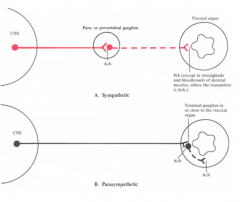
- Pre: short
- Post: long |
|
|
What is the length of preganglionic and postganglionic fibers in the PNS?
|
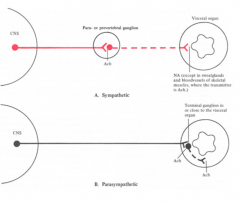
- Pre: long
- Post: short |
|
|
Sympathetic fibers leave the spinal cord at what levels?
|
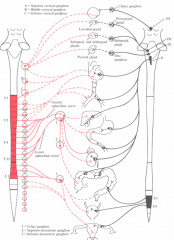
Thoracolumbar: T1-L2
|
|
|
Parasympathetic fibers leave the spinal cord at what levels?
|
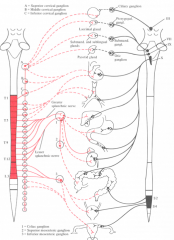
Craniosacral: CN III, VII, IX, X; S2-S4
|
|
|
Which cranial nerves have parasympathetic function?
|
CN III, VII, IX, X
|
|
|
What are the four courses of a sympathetic preganglionic axon?
|
1. Establish synaptic contact with postganglionic neuron in paravertebral chain (sympathetic trunk) at same level
2. Pass up or down sympathetic trunk to synapse on postganglionic neuron at different level 3. Pass through paravertebral ganglion to contact postganglionic neuron in a prevertebral ganglion (celiac, sup. or inf. mesenteric) 4. Pass through paravertebral ganglion en route to adrenal medulla |
|
|
CN III - Oculomotor:
- Brainstem Nuclei - Peripheral Ganglia - Target Organ |
- Edinger-Westphal Nucleus
- Ciliary Ganglia - Sphincter Pupillae m. |
|
|
CN VII - Facial:
- Brainstem Nuclei - Peripheral Ganglia - Target Organ |
- Superior Salivatory Nucleus
- Pterygopalatine Ganglia --> Lacrimal Gland (crying) - Submandibular Ganglia --> Sublingual and Submandibular (saliva) |
|
|
CN IX - Glossopharyngeal:
- Brainstem Nuclei - Peripheral Ganglia - Target Organ |
- Inferior Salivatory Nucleus
- Otic Ganglia - Parotid Gland (saliva) |
|
|
CN X - Vagus:
- Brainstem Nuclei - Peripheral Ganglia - Target Organ |
- Dorsal Motor Nucleus
- Myenteric and Submucosal (terminal) Ganglia - Smooth muscle and glands of GI tract |
|
|
What are the symptoms of Vasovagal Syncope?
|
1. Muscle weakness
2. Warm sensation 3. Nausea 4. Sweating |
|
|
What is the possible explanation for Vasovagal Syncope?
|
- Peripheral venous pooling -->
- Splanchnic pooling activates low pressure mechanoreceptors (interpreted by brain as increased venous pressure) --> - Withdrawal of sympathetic activity and increase in vagal activity --> - Inappropriate peripheral vasodilation and bradycardia --> - Hypotension and syncope |
|
|
What are the ANS components of the baroreceptor reflex?
|
- Stretch receptors in carotid sinus (IX) and aortic arch (X)
- Glossopharyngeal n. (IX) and vagus n. (X) provide afferent limb - CNS processing in nucleus solitarius - Efferent limb: PNS axons of CN X from neurons in dorsal motor nucleus (cardioinhibitory) - Efferent limb: SNS interomediolateral cell column of spinal cord (cardiostimulatory and pressor responses) |
|
|
What ANS receptors are involved in the baroreceptor reflex?
|
Stretch receptors in carotid sinus (IX) and aortic arch (X)
|
|
|
What nerve carries the afferent information for the baroreceptor reflex?
|
Glossopharyngeal (IX) and Vagus (X)
|
|
|
Where is the baroreceptor reflex processed?
|
In the CNS - Nucleus Solitarius
|
|
|
What nerve carries the efferent information for the baroreceptor reflex?
|
- PNS: axons of Vagus (X) from neurons in dorsal motor nucleus (cardioinhibitory)
- SNS: interomediolateral cell column of spinal cord (cardiostimulatory and pressor response) |
|
|
What are the symptoms of Horner's Syndrome?
|
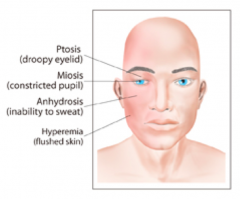
- Ptosis (drooping eyelid)
- Miosis (constriction of pupil) - Anhidrosis (inability to sweat) - Enophthalmos (posterior displacement of eyeball within orbit due to ptosis) |
|
|
What is the cause of Horner's Syndrome?
|
- Loss of sympathetic innervation (dilator pupillae m., superior tarsal m., facial sweat glands)
- Cervical sympathetic pathway from hypothalamus is interrupted (may be central, preganglionic, or postganglionic in origin) |
|
|
In what Syndrome is Horner's Syndrome a part of?
|
Part of Lateral Medullary Syndrome, AKA Wallenberg Syndrome
|
|
|
What is the other name for Lateral Medullary Syndrome? Symptoms?
|

- Wallenberg Syndrome
- Dysarthria - Dysphagia - Contralateral loss of pain and temperature - Ipsilateral loss of facial sensation - Horner's Syndrome (ptosis, miosis, anhydrosis, enopthalmos) |
|
|
Autnomic Dysreflexia affects people with spinal cord injuries at what level?
|
T5 and above
|
|
|
What is the cause of Autonomic Dysreflexia?
|
Disordered autonomic response - causes sympathetic hyperreflexia
|
|
|
What kind of stimulus can trigger Autonomic Dysreflexia?
|
Overfull bladder (blocked catheter) or noxious stimulus --> Causes activation of sympathetic outflow
|
|
|
What are some symptoms of Autonomic Dysreflexia following a spinal cord injury?
|
- Headache
- Hypertension - Bradycardia - Piloerection - Pallor - Can be life-threatening |
|
|
What is the route for controlling micturition (urination)?
|
S2-S4 --> Pelvic Splanchnic nerves --> Inferior Hypogastric Plexus --> Postganglionic Fibers --> Detrussor Muscle --> Contraction (Micturition)
|
|
|
What is the route for controlling urinary storage?
|
1) Interomediolateral cell column (T11-L2) --> Lumbar Splanchnic Nerves --> Internal Urethral Sphincter --> Contraction --> Storage
2) Somatic Motor Innervation (S2-S4 / Pudendal n.) --> External Urethral Sphincter --> Contraction --> Storage |
|
|
How is male reproductive function controlled by the ANS?
|
- Sexual stimulation --> Erection (vascular and controlled by PNS)
- Ejaculation --> Emission and ejaculation (controlled by SNS and somatic control) |
|
|
How is female reproductive function controlled by the ANS?
|
- External genitalia by ilioinguinal and perineal nerves (somatic)
- Internal reproductive structures receive not only autonomic innervation, but also regulated by hormones |
|
|
What is the cause of Hirschprung's Disease?
|
- Congenital absence of myenteric (Auerbach's) plexus
- Failure to produce ganglion cells located between layers of muscularis externa - No peristalsis in denervated colon (appears small) compared to proximal part of colon which becomes distended |
|
|
What are the symptoms of Hirschprung's Disease? Treatment? |
- Constipation
- Surgically attach normal colon to rectum |

